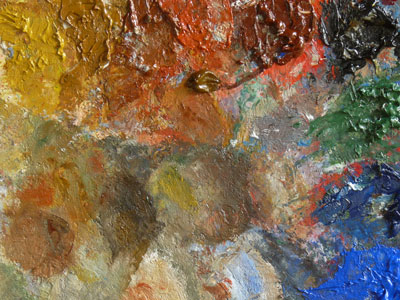
Tracing a thought back to its origin is always intriguing, especially if it turns out to be life changing. Almost 30 years ago, while walking away from a large museum --released from, yet still very much under its spell -- I had, for better or worse, what turned out to be such a thought. Dimly, it occurred me that, while modern paintings looked better in reproduction, older paintings somehow looked better in person. Probably felt would be a more accurate term. I was under 30, still struggling with an education that was less complete or sophisticated than I thought, and, slowly becoming aware of the limitations of the 20th century art I had grown up with, beginning to become aware of painting in larger historical terms. Often modern paintings looked a little dingy or shopworn in the flesh, or had, in more extreme cases, obviously darkened or yellowed. The best of older painting offered something beyond this, a kind of seamless fusion of form and content, of craft and intention, that was satisfying at a deeper level than the more topical, intellectual, or edgy qualities that dominated modern painting. Older painting also had a significantly more evolved sense of the surface, of what could happen optically and technically within a few millimeters of paint. I wanted to get as close to them as possible, the museum guard's nightmare. This is not to idealize older painting, which has had its fair share of facile yet vacuous moments: encountering a Boucher for the first time, for example, was disconcerting compared to the stark sincerity of the Quattrocento, and it was helpful to discover, even decades later, how much Boucher had annoyed Diderot. On the other hand, it never seemed appropriate to condemn modern painting, just to realize that it was varied and complex as well. The original spirit of freedom and spontaneity, freshness and candor, obviously still has much to offer. Yet, it often seemed that something was missing, both technically and at that recurring deeper level. Older painting had an extra dimension in a more developed craft, another in its sense of strength in reserve; of being painted from a different level of purpose and conviction.
Being part of a generation that grew up with the chosen intensity of modern art, the idea of images crafted for a relationship longer than fifteen seconds required consideration. It suggested a slower version of time, and, by extension, a more examined kind of life. While older paintings could certainly be lively, they were not always shouting, and the fact that this was not felt to be prerequisite was, personally, a relief. Admittedly, I had always looked to art for something beyond visual or intellectual entertainment. I wondered if, similar to the progression defined by Orwell in Animal Farm, modern art had developed into a form of aesthetic tyranny all too similar to that from which it had originally rebelled. A sense that painting had been, and therefore could be, about much more than I had previously realized, began to develop. It was fascinating that older painters knew so much more than I did, that they were speaking both a visual and technical language I simply could not comprehend. Even more thought provoking, this knowledge could be seen in action without the slightest understanding of the craft that enabled the methods. This was very interesting.
These thoughts, developing over the next few years or so as I taught myself the rudiments of traditional oil painting, are not presented for their brilliance or originality, but to illustrate the recurring proximity of naivete and personal truth. While I knew next to nothing about what older painting entailed technically, the equation of relevance had already established itself. Old painting and new painting each had specific general identities. Could the meaningful aspects of both somehow be brought together, blended in a way that might maintain the intriguing qualities of each? Blissfully unaware of the long term consequences, I began to wonder about how these different approaches might be reconciled in a functional synthesis.
Fifteen years later, this thought had crystallized into a need to develop the craft beyond the modern model. This had begun to seem like a flat earth version of the craft. Where was the original globe? It quickly became clear that it was impossible to achieve anything remotely like this with the accepted 20th century materials I knew: the look was altogether too facile. Did modern paint somehow have the "wrong" qualities to begin with? In terms of color, the crucial element of chromatic dignity was also firmly out of reach. Vivid modern colours seemed glib or superficial; how to access colour with more sonority, gravity, depth of feeling? On the one hand, this was frustrating, but on the other hand, the puzzle remained tremendously interesting: it could be seen, but not unraveled. I had always been drawn to learning new things, but here was something that, apparently, could not be learned. The door was not only closed, it was bolted, locked, and guarded by Cerberus. Yet, how could something this fundamental to older painting practice have become so obscured? Or, in fact -- that fateful word -- lost? The current books said one thing technically, but older painters had clearly done something very different. What was going on here? Why was older practice enthroned in art history, but deprecated in print by current painting professors? Having always found the superiority of modernity dubious in application, this conundrum proved too intriguing to ignore.
Thus began a long journey into the labyrinth of how older painting technique might be accessed and, in some way, reconstructed. Thankfully I had no idea how many painters had been fascinated, even ensnared, by this same puzzle, or the legendary difficulties it entailed.
To be continued...